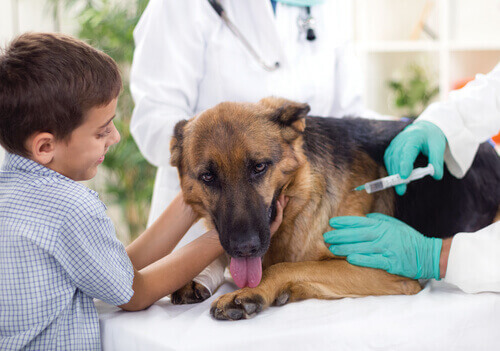Vasculitis in Dogs: What Do You Need to Know?

In the world of medicine, there are certain clinical signs that help veterinarians made diagnoses. In the case of vasculitis in dogs, this disease can provide you with valuable information regarding the existence of other diseases.
When there are signs of another disease, experts refer to this as a “secondary” illness. Vasculitis in dogs is usually a secondary illness. For example, if a clinical veterinarian detects vasculitis in dogs, they should then delve further into the nature and origin of the condition.
What is vasculitis?
Vasculitis is an inflammation of the blood vessels caused by an injury to the endothelium. The endothelium is the inner layer that lines the blood vessels. Vasculitis also occurs due to the extension of another inflammatory or infectious process.
When there’s damage to the blood vessel, there’s inflammation of the vascular tissue. During inflammation, enzymes can cause significant damage to the wall of the blood vessel. Then, this can cause bleeding and necrosis in the affected area.
- Vasculitis can occur in the skin. In this case, it’s called cutaneous vasculitis.
- On the other hand, it can also occur systemically. This means that it affects the animal generally.
In terms of the observable lesions caused by cutaneous vasculitis, it’s common to see ulcers, necrosis, or blisters in the affected area. Mucous membranes, such as the edges of the ears and footpads, are common areas for the lesion to develop. These signs are common when vasculitis is present.
Other symptoms might include depression, fever, edema, or joint pain. These depend on the primary cause and are common with systematic vasculitis.

Causes of vasculitis in dogs
As we mentioned previously, there are many diseases that can lead to the development of vasculitis. We’re going to discuss the most common:
- Infectious causes: There are several infectious causes, such as various parasites like heartworm. Viruses or certain bacteria can also cause the disease, such as canine coronavirus.
- Immune-mediated causes: Certain conditions involving the immune system can lead to the development of vasculitis. For example, it can be caused by an adverse reaction to drugs or vaccines, food hypersensitivity, rheumatoid arthritis, systematic lupus, or erythematosus, among other diseases.
Treatment of vasculitis in dogs
In treating vasculitis in dogs, your vet will always focus on solving the primary cause of the problem. Occasionally, a vet will only be able to give a prognosis for vasculitis once they resolve the primary disease. However, as there are so many variables involved, your vet may struggle to discover the causative issue early.
While determining the origin of the problem, your vet will most likely recommend the use of preventive antibiotics. Other experts recommend using corticosteroids as anti-inflammatories and immunosuppressants. However, studies have not shown these procedures to be fully effective.
Vasculitis in dogs from the rabies vaccine
One cause of vasculitis is actually the administration of the rabies vaccine. According to some experts, this is the most frequent cause of the illness. Researchers have frequently found this in breeds such as Miniature Poodles, Yorkshire Terriers, Pekingese, or Maltese Bichons.
In these animals, you may see a lesion appear following the administration of the vaccine, in the form of localized alopecia.
For example, you might see hair loss where the dog received a vaccine. This can occur between the first and fifth month after application. In addition to this, you can also see scabs or ulcers on different areas of the body, such as the tips of the ears or lips.

It’s important to remember that reading an article is never sufficient to make a diagnosis or start treatment. This is just for you to be aware of issues to look out for in terms of issues with your dog.
In case your dog suffers an injury, you should also go to a trusted veterinarian. You should never give medication without a prescription from a vet.
